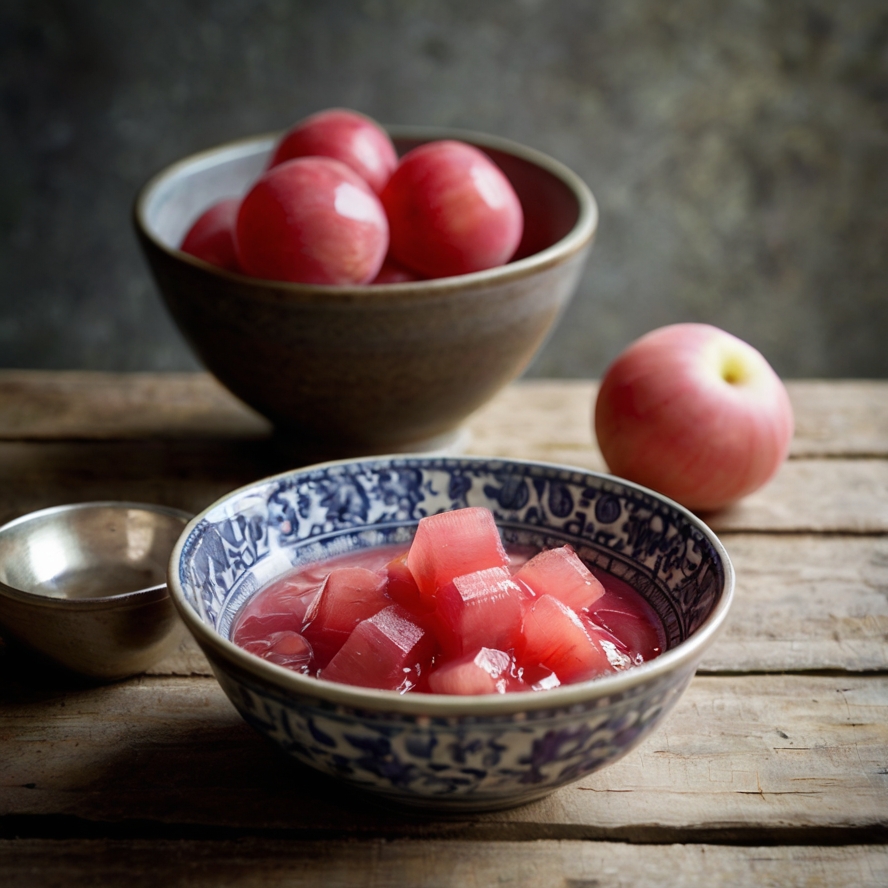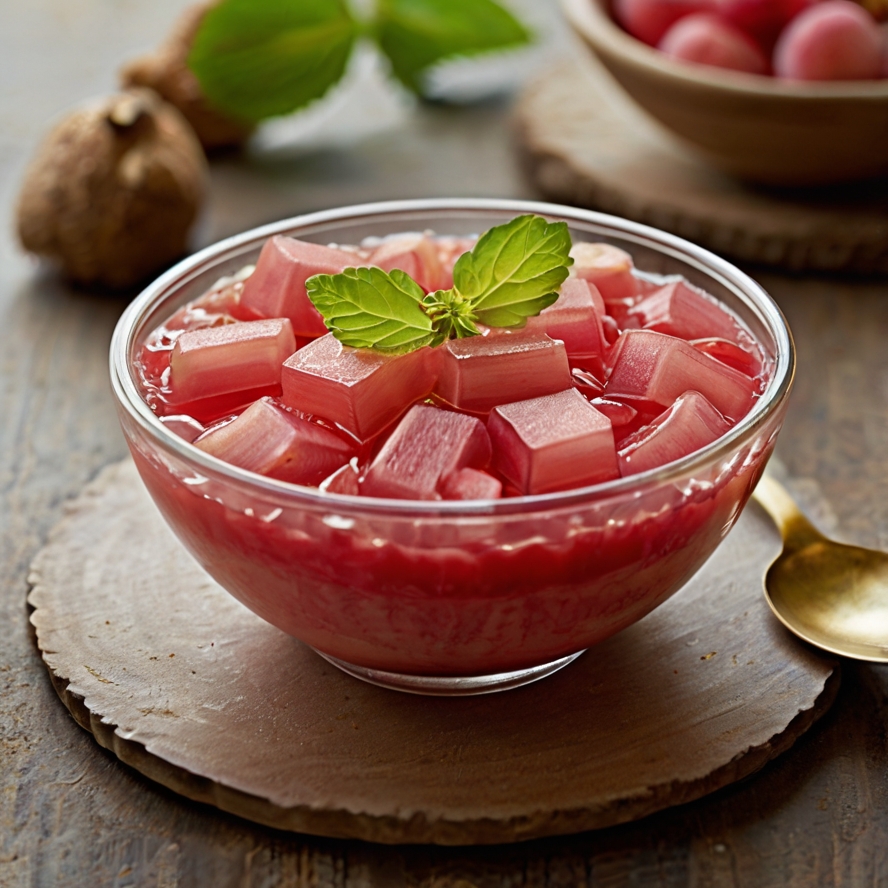Rhabarberkompott, or rhubarb compote, is a popular dessert in German cuisine, made by simmering rhubarb with sugar to transform the tart fruit into a sweet treat. Often paired with vanilla ice cream or custard, it can also be used as a topping for cakes, yogurt, or pancakes. Rhubarb is rich in antioxidants and vitamin C, which support immune health and help reduce inflammation. The high fiber content promotes digestive health, though it may cause discomfort in sensitive individuals if consumed in excess. Overall, rhubarb compote is a delicious and nutritious dessert that offers a unique flavor with several health benefits when enjoyed in moderation.
Ingredients:
- 4 cups rhubarb, chopped into small pieces
- 1/2 cup sugar (adjust to taste)
- 1/2 cup water
- 1 teaspoon vanilla extract (optional)
- 1 tablespoon lemon juice (optional)
Instructions:
1. Prepare the Rhubarb:
- Start by thoroughly washing the rhubarb stalks. Remove the tough ends and discard the leaves, as they contain oxalic acid, which can be toxic. Cut the rhubarb stalks into small, even pieces (about 1-inch lengths). This ensures uniform cooking and a better texture for the compote.
2. Combine Ingredients in a Saucepan:
- In a medium-sized saucepan, combine the chopped rhubarb, sugar, and water. Stir gently to mix the ingredients together. The sugar will begin to dissolve, and the water will help cook the rhubarb without it sticking to the bottom of the pan.
3. Simmer the Rhubarb:
- Place the saucepan over medium heat and bring the mixture to a simmer. Once the liquid starts to bubble gently, reduce the heat to low to maintain a simmer. Allow the rhubarb to cook for about 10-15 minutes. Stir occasionally to prevent burning and to ensure that the rhubarb cooks evenly.
4. Check the Consistency:
- As the rhubarb simmers, it will break down and release its juices, creating a soft, syrupy mixture. After 10 minutes, check the consistency. The rhubarb should be tender and the liquid should have thickened slightly. If you prefer a smoother compote, you can mash the rhubarb with a fork or potato masher at this point. For a chunkier texture, leave the pieces as they are.
5. Add Optional Flavorings:
- If desired, stir in 1 teaspoon of vanilla extract and 1 tablespoon of lemon juice. The vanilla adds a subtle, warm note to the compote, while the lemon juice enhances the tartness of the rhubarb and helps balance the sweetness from the sugar.
6. Cool the Compote:
- Remove the saucepan from the heat and allow the compote to cool for a few minutes. The mixture will continue to thicken as it cools. If you prefer a thicker compote, let it sit at room temperature until it reaches your desired consistency.
7. Serve and Enjoy:
- Rhabarberkompott can be served either warm or chilled, depending on your preference. Spoon it into bowls and enjoy it as a standalone dessert or pair it with ice cream, custard, or a variety of baked goods.
Alternative Serving Suggestions:
Rhubarb compote is a versatile dessert that pairs wonderfully with various foods. Here are some ideas:
- With Breakfast: Use it as a topping for oatmeal, granola, or yogurt. Its tangy flavor complements creamy textures beautifully.
- With Pastries: Spread it over crepes, pancakes, or waffles for a fruity twist.
- With Desserts: Serve it alongside vanilla ice cream, custard, or even drizzle it over cheesecakes and pound cakes.
- Creative Presentation: Layer rhubarb compote with whipped cream and crushed biscuits in a glass to create a quick and elegant parfait.
Tips to Enhance the Recipe:
- Healthier Sweeteners: Replace sugar with natural alternatives like honey, maple syrup, or coconut sugar for a healthier option. Adjust quantities based on the sweetness level desired.
- Flavor Variations:
- Add a pinch of cinnamon or ginger to the compote for a warm, spicy flavor.
- Mix in other fruits like strawberries, apples, or pears to create a unique fruit blend.
- Texture Options: Blend the compote for a smoother consistency or leave some rhubarb chunks for a rustic texture.
Additional Warnings:
- Oxalic Acid in Rhubarb: Rhubarb contains oxalic acid, particularly in its leaves, which can be toxic. Always discard the leaves and peel the stalks if they are fibrous. People with kidney issues should consume rhubarb in moderation, as oxalic acid can contribute to kidney stone formation.
- Seasonality: Fresh rhubarb is best used in spring and early summer. Out-of-season rhubarb may not have the same flavor or nutritional benefits.
Frequently Asked Questions:
How long does rhubarb compote last?
- Rhubarb compote can be stored in an airtight container in the refrigerator for up to one week. For longer storage, freeze it in portions for up to three months. Thaw in the fridge overnight before use.
Can I make the recipe without sugar?
- Yes, you can substitute sugar with natural sweeteners like honey, maple syrup, or stevia. Alternatively, use sweet fruits like strawberries to reduce the need for added sweeteners.
How can I tell if rhubarb is fresh?
- Look for bright, firm stalks with a deep red or pink hue. Avoid stalks that are limp, dry, or have blemishes. Fresh rhubarb will snap cleanly when bent.
Can I use frozen rhubarb?
- Absolutely! Frozen rhubarb works well for compote. There’s no need to thaw it beforehand—just adjust the cooking time slightly as the frozen rhubarb releases more water.

Nutritional values and benefits:
4 Cups Rhubarb (about 600g)
- Calories: 120
- Carbohydrates: 28g
- Protein: 2g
- Fat: 0g
- Sodium: 10mg
- Cholesterol: 0mg
- Vitamins:
- Vitamin C: 10mg (17% DV)
- Vitamin K: 25mcg (21% DV)
- Minerals:
- Calcium: 80mg (8% DV)
- Potassium: 500mg (14% DV)
- Benefit: Rhubarb is low in calories and provides a good amount of fiber, which promotes digestion. It is rich in vitamin C, an antioxidant that boosts immunity, and vitamin K, which is important for bone health. Rhubarb also contains calcium and potassium, both essential for maintaining strong bones and regulating fluid balance.
1/2 Cup Sugar (100g)
- Calories: 400
- Carbohydrates: 100g
- Protein: 0g
- Fat: 0g
- Sodium: 0mg
- Cholesterol: 0mg
- Vitamins:
- No significant vitamins
- Minerals:
- No significant minerals
- Benefit: Sugar adds sweetness to the compote. However, it’s important to use sugar in moderation as part of a balanced diet. Excessive sugar intake can contribute to health issues such as weight gain and increased risk of type 2 diabetes.
1/2 Cup Water (120ml)
- Calories: 0
- Carbohydrates: 0g
- Protein: 0g
- Fat: 0g
- Sodium: 0mg
- Cholesterol: 0mg
- Vitamins:
- No significant vitamins
- Minerals:
- No significant minerals
- Benefit: Water is essential for hydration and helps dissolve the sugar and rhubarb, creating a smooth compote. Staying hydrated is vital for maintaining healthy skin, digestion, and overall bodily functions.
1 Teaspoon Vanilla Extract (optional)
- Calories: 12
- Carbohydrates: 0g
- Protein: 0g
- Fat: 0g
- Sodium: 0mg
- Cholesterol: 0mg
- Vitamins:
- No significant vitamins
- Minerals:
- No significant minerals
- Benefit: Vanilla extract adds a rich, aromatic flavor to the compote. It also has antioxidant properties, which may help protect cells from oxidative stress.
1 Tablespoon Lemon Juice (optional)
- Calories: 4
- Carbohydrates: 1g
- Protein: 0g
- Fat: 0g
- Sodium: 1mg
- Cholesterol: 0mg
- Vitamins:
- Vitamin C: 10mg (17% DV)
- Minerals:
- Potassium: 20mg (1% DV)
- Benefit: Lemon juice is a natural source of vitamin C, which supports immune health, and it enhances the tartness of the rhubarb. It also helps balance the sweetness of the sugar and adds a refreshing flavor to the compote.
Summary of Nutritional Benefits:
Rhabarberkompott is a nutritious and low-calorie dessert that provides fiber, antioxidants, and essential vitamins and minerals like vitamin C, potassium, and calcium. While sugar is used to sweeten the dish, you can adjust the amount to suit your taste. The addition of lemon juice and vanilla extract can enhance the flavor profile while offering extra antioxidants. Rhubarb's natural tartness makes this compote a refreshing and healthy treat for any occasion.


Comments